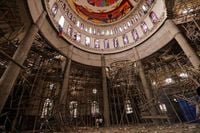In the quiet town of Arerti in Ethiopia’s Amhara region, what was meant to be a day of joyous celebration quickly turned into one of the deadliest tragedies in recent memory. On the morning of October 1, 2025, as worshippers gathered for the annual Orthodox Christian celebration of St. Mary at the still-under-construction Arerti St Mary’s Church, disaster struck. The wooden scaffolding, hastily erected to support ongoing construction and to offer a vantage point for a newly painted ceiling mural, gave way under the weight of the crowd. The collapse killed at least 36 people and injured more than 200, according to local authorities and eyewitness accounts reported by Reuters, BBC, and Associated Press.
The scene was chaotic and heart-wrenching. Hundreds of worshippers, including children and the elderly, had flocked to the church for the Marian feast—a day meant to be filled with prayer, music, and community. Instead, the festivities were cut short by the thunderous crash of collapsing timber, followed by screams and the desperate scramble of people trying to escape or rescue those trapped beneath the debris. "We all had gathered in prayers when all of a sudden the scaffolding collapsed and people started falling from the ceiling," said Mikias Mebratu, a witness who lost three friends in the disaster, as quoted by the Associated Press.
Eyewitnesses described the moments leading up to the tragedy with chilling detail. Many worshippers had climbed the wooden scaffolding to get a closer look at the freshly painted mural on the church’s ceiling—a mural that, for a brief moment, was the centerpiece of communal pride and curiosity. Gebreweld Tesfaye told the BBC, "The staircase was entirely wooden, and there were many people moving upstairs at the time. As the congregants were going, the wooden structure gave way, leading to the collapse." The collapse was sudden and devastating, leaving little time for those in the middle of the structure to escape. "What caused the damage was when the scaffolding crumpled. It just crushed the people beneath. Some who were on the peripheries ran outside, but those in the middle perished," survivor Tadesse Tesfaye told Reuters.
In the aftermath, the scale of the tragedy became horrifyingly clear. According to police chief Ahmed Gebeyehu, at least 36 people were confirmed dead, while more than 200 suffered injuries—some so severe that they required transfer to hospitals in Addis Ababa, about 70 kilometers away. The local hospital, overwhelmed by the influx of wounded, called on the Red Cross for urgent assistance. Seyoum Altaye, a clinician at the hospital, told the Associated Press, "So far we have confirmed 25 dead and over a hundred injured." He noted that the victims included children and elderly people, and that the true toll could rise as more succumbed to their injuries.
The day after the collapse, the community gathered again—this time in mourning. Mass funerals were held for the victims, with hundreds of mourners walking somberly behind coffins draped in colorful cloth, as clerics conducted burial rituals. Among those grieving was 22-year-old Fikre Tilahun, who lost his mother in the tragedy. He told the BBC, "It's difficult to lose your mother, very difficult." Fikre recounted his frantic search for his mother in the aftermath, only to find her body at the hospital. "She raised us by making and selling tella [a locally brewed liquor]," he said, reflecting on the personal loss that echoed through so many families in Arerti.
The church itself, a symbol of faith and community, now stood as a stark reminder of the disaster. The day after the incident, victims’ shoes and sandals were found piled next to broken masonry and snapped scaffolding poles beneath the church’s freshly painted dome, reported Reuters. The twisted remains of the scaffold—meant to support both construction and the faithful—remained in place, a haunting testament to the fragility of human endeavor in the face of tragedy.
The response from religious leaders and the broader Ethiopian community was swift and heartfelt. Cardinal Berhaneyesus, speaking on behalf of the Ethiopian Catholic Bishops’ Conference, expressed profound sorrow and solidarity with the Ethiopian Orthodox Tewahedo Church. "We are deeply saddened to learn that wooden scaffolding used in the construction of the Ethiopian Orthodox Tewahedo Church in the North Shewa Diocese at Ararti Debre Genet St. Mary’s Church has collapsed, resulting in the loss of many lives and injuries to many others," Cardinal Berhaneyesus stated, according to Vatican News. The cardinal offered prayers for the ministers of the church and for the families of those who lost loved ones.
The archbishop of the local diocese, Megabi Hadis Nekatibeb, described the disaster as "incredibly tragic and heart-breaking," BBC reported. The Ethiopian government also extended its condolences to the relatives of the victims and emphasized that "safety must be given priority" during all construction projects. This tragedy has cast a harsh spotlight on the state of health and safety regulations in Ethiopia, where enforcement is often lax and construction accidents are, unfortunately, not uncommon.
Local administrator Teshale Tilahun warned that the death toll could rise as critically injured victims continued to fight for their lives. "It is a tragic loss for the community," he told the Associated Press. The sense of loss was palpable throughout Arerti and beyond, as Ethiopians from all walks of life expressed their grief and called for greater attention to safety standards in places of worship and public gathering.
For many, the disaster has raised urgent questions about accountability and the need for better oversight of construction practices, especially in settings where large crowds are expected. The government’s call for improved safety measures has been echoed by religious leaders and civil society alike, who see this tragedy as a wake-up call for the nation.
As the community of Arerti begins the long process of mourning and recovery, the memories of those lost will linger. Their lives, cut short in the midst of celebration, serve as a somber reminder of the importance of vigilance, compassion, and unity in the face of adversity. The church, once a site of joyful gathering, will now also be a place of remembrance, its future shaped by the lessons learned from this heartbreaking event.



